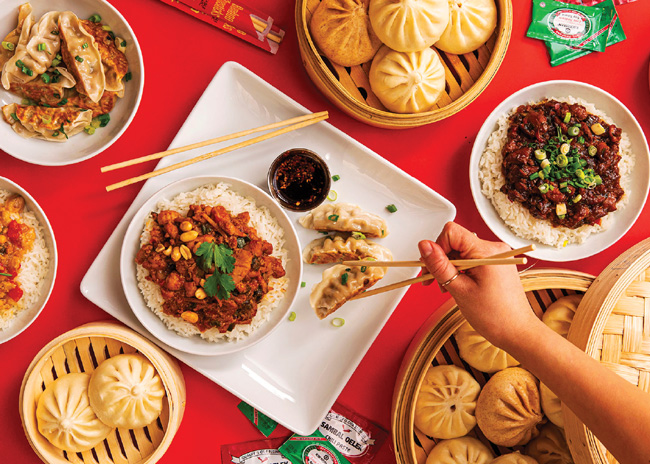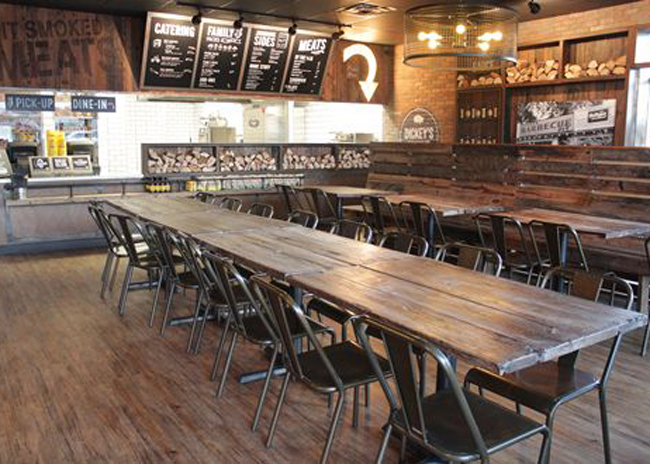In November 2019, Wow Bao, a quick-service chain specializing in noodles, rice and steamed Asian buns, launched a program that would inadvertently help the brand weather the storm of COVID-19.
Wow Bao created a “dark kitchens” initiative that meant teaming up with other restaurants, ones that could use their existing, underutilized, kitchens to serve Wow Bao menu items that had been shipped frozen to the location in advance.
In late November, Wow Bao was being served out of 100 “ghost” kitchens nationwide with another 50 to 60 expected to be added by year’s end.
In a year that was devastating for restaurants, finding alternate ways to do business has been a key to survival. Some restaurants are exploring ghost kitchens to keep up with the demand of pickup and delivery orders, some are moving into nontraditional spaces, and still others are exploring options that they wouldn’t have thought possible pre-COVID-19.
This trend, says Darren Tristano, CEO of consulting firm Foodservice Results, Chicago, “is continuing to grow and is likely to continue to grow post-pandemic. As consumers get used to buying products in nontraditional venues, their comfort level will grow, and familiarity will build return visits. Expect the trend in off-premises-only restaurants to thrive and do well with lower rent due to eliminating dining rooms.”
For Wow Bao, the dark kitchens have been a big success — but they’ve also been a win for partner restaurants. “Every restaurant operator is facing the same problem right now, and we’ve found a way to help restaurants grow sales,” says Geoff Alexander, president and CEO of the Chicago-based brand.
Restaurants sign up with Wow Bao and then receive the frozen food items required for the limited menu they’ll offer. Sign-up costs range from $495 to $800 (as of December 2020), but the goal is for partner restaurant to make $2,000 a week in sales through Wow Bao by week six, Alexander explains. However, he has one location making $6,500 a week and another making $9,000.
Before launching the dark kitchens initiative, Wow Bao pared down its menu to offer just the top 30% of menu items (though partner restaurants can add dishes). It’s streamlined to make it easy for the operators and to reduce storage needs. “That’s the trick — the simplicity of it,” Alexander says. The food is shipped to the restaurants fully cooked and finished at the restaurant level.
All Wow Bao food items are picked up from the partner restaurants by third-party delivery servicers. Wow Bao handles the marketing of items on third-party delivery sites and social media platforms. “We do targeted Instagram and Facebook ads within a 3- to 5-mile radius,” says Alexander.
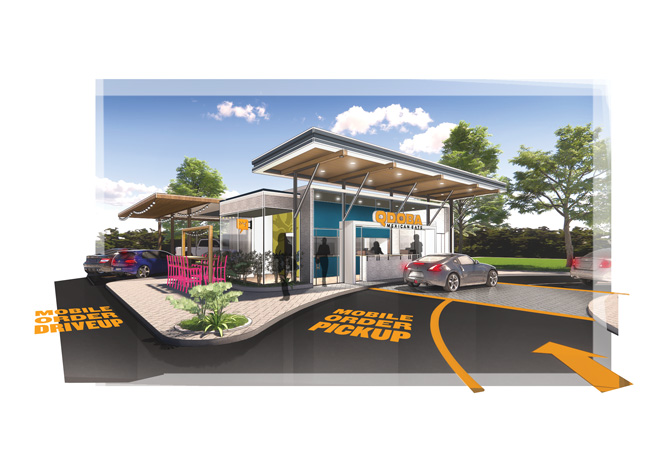 Qdoba Mexican Eats' latest prototype features a mobile pickup window. Image courtesy of Qdoba Mexican Eats
Qdoba Mexican Eats' latest prototype features a mobile pickup window. Image courtesy of Qdoba Mexican Eats
Frontiers in Digital Development
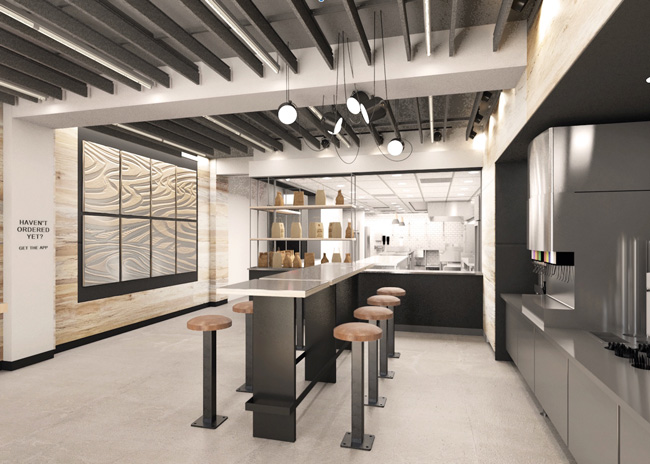 In November, Chipotle opened a digital kitchen in Highland Falls, N.Y. Customers order online and visit the lobby to collect their food. Image courtesy of ChipotleAnother restaurant pursuing new opportunities is Chipotle. In November, the Newport Beach, Calif.-based concept opened its first digital kitchen — in Highland Falls, N.Y. This is a kitchen-only concept with a lobby. Customers order through the company’s app, then visit the lobby to collect their food.
In November, Chipotle opened a digital kitchen in Highland Falls, N.Y. Customers order online and visit the lobby to collect their food. Image courtesy of ChipotleAnother restaurant pursuing new opportunities is Chipotle. In November, the Newport Beach, Calif.-based concept opened its first digital kitchen — in Highland Falls, N.Y. This is a kitchen-only concept with a lobby. Customers order through the company’s app, then visit the lobby to collect their food.
Tabassum Zalotrawala, chief development officer, foresees more of these store types opening in 2021 to keep up with increasing online sales. In the third quarter of 2020, Chipotle’s digital sales grew by 200% over the same period in 2019.
“It became important to start innovating around the type of experience our customers were seeking,” she says, “and from a real estate standpoint it’s really important. If you have only one type of restaurant, you’re precluded from so many trade areas.”
The digital-order only Chipotles will come in various formats. One option doesn’t even have an interior but just a drive-thru pickup window. In order to retain the open-kitchen look and feel of the Chipotle brand, however, that prototype will likely have glass walls on the pickup side of the kitchen. “It’s really important to continue the brand,” Zalotrawala says. “The transparency piece is one of our key pillars for design.”
They new formats will also be much smaller than typical Chipotles with dining rooms. And, because of the decreased space, these units are faster and less expensive to build-out, Zalotrawala says. Build-out costs are estimated to be 30% to 35% less than traditional format stores.
The Highland Falls Chipotle was selected, Zalotrawala says, after the chain evaluated the area’s demographics and discovered a captive audience of cadets in the military academy there. That audience is also young, so comfortable with ordering via an app, though Zalotrawala has seen that comfort level grow among all ages since the dawn of the pandemic.
Chipotle also added a new, innovative feature to its digital kitchen: They’ve separated shelves for delivery or catering and pickup. “Both of these need to be just as convenient for our crew members. It creates a very efficient work triangle that you need from your cookline to your makeline to either your window or the mobile order pickup shelves,” says Zalotrawala. “Our catering boxes take up a lot more real estate than our brown bags, so we knew we needed a dedicated entrance for delivery pickup and catering pickup.”
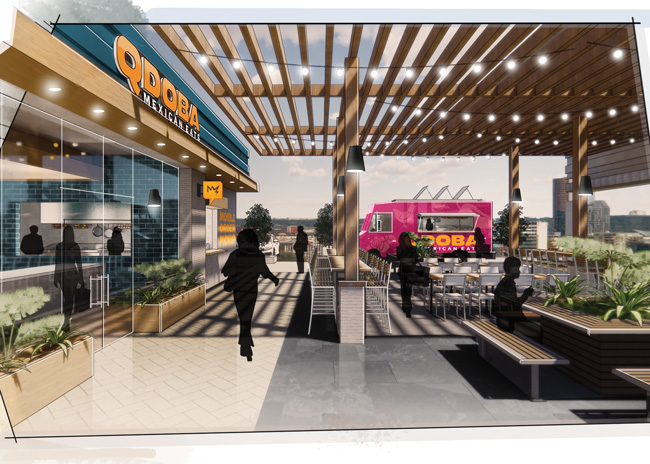 Image courtesy of Qdoba Mexican Eats
Image courtesy of Qdoba Mexican Eats
Flexible Formats Reign Supreme
Qdoba Mexican Eats is taking a multipronged approach to expansion. Two years ago, the concept opened its first ghost kitchen in its hometown of San Diego. This unit performed well, encouraging the brand to open more, so now it has a handful across the country, run by franchisees.
“Ghost kitchens are a way to get into a market quickly and gain brand awareness,” says Tim Welsh, chief development officer. The ghost kitchens can be used to either build that awareness prior to opening a traditional store — their first ghost kitchen recently converted to a traditional store — or to allow Qdoba to open in a smaller space and to service digital orders, which can be very appealing to franchisees wanting to open a number of locations.
In Baltimore, for example, the brand already has great brand awareness, Welsh says, but there’s the opportunity for 30 more stores “before we reach saturation,
so we could pop up a bunch of ghost kitchens to meet that need.” Some areas, he says, will be almost 100% ghost kitchens, but the company will continue to build traditional stores, too.
The ghost kitchens go into spaces that are much smaller — around 800 square feet — so the build-out costs are significantly less, he says. And typically, since they’re usually second-gen spaces, the build-out time is vastly reduced too.
But Qdoba’s big focus right now is drive-thru locations. It had a handful of locations pre-pandemic, Welsh says, typically in second-generation locations, but before the pandemic, drive-thrus were more closely linked with QSRs than fast-casual restaurants. “But what we’ve seen during COVID is they could maintain business by shifting from the dining room to the drive-thru. We see that as sticking, and we’ve put a lot of energy into transforming and innovating our drive-thrus."
These, says Welsh, “are a great way to bring brand awareness to millions of people.” They’ll range from 1,500 square feet for drive-thru locations to 2,700 square feet for drive-thrus with dining rooms.
One more piece to the Qdoba puzzle is the chain is looking to add mobile lockers for hot food pickup. While it’s still early in the conceptual phase, Welsh anticipates these being added to smaller format drive-thru only locations, or ghost kitchens that have no consumer-facing business. In the future, he sees these possibly being added to high-density office buildings as well. He expects them to launch late in 2021.
Del Taco is also keen on drive-thrus and will start launching drive-thru only locations in 2021. Its new prototype for this is around 1,200 square feet and is just one variation of what the Lake Forest, Calif.-based brand will offer going forward.
The brand has redesigned its standard 65-seat, 2,440-square-foot prototype, starting with the kitchen, then scaled the building around that. “We call it our ‘menu of venues strategy,’” says Jeff Little, senior vice president of development. “It starts at the small end with our drive-thru and then we enlarge from there with several iterations of what I’ll call ‘reduced dining room’ buildings.” It scales up to the largest prototype at 2,300 square feet with around 55 seats.
Having this smaller footprint, says Little, “will definitely help us with infill plays in our densely penetrated core market (in California). Beyond that, we see a lot of applicability for this building in urban, high-density markets that are difficult to penetrate because the real estate availability is tight.” This could also help the brand take advantage of pandemic-related site opportunities, Little notes.
Along with offering a more efficient kitchen, the new prototype reduces build-out costs by around 10%, making Del Taco more attractive to franchisees, Little notes. It’s also likely that build-out time will be significantly cut, he says, perhaps by as much as 25 days.
As digital orders and third-party delivery continue to rise, Little says, “you need to be forward-thinking in terms of how you remove pinch points for the consumer and are able to quickly and efficiently satisfy the guest no matter which platform they’re using.”
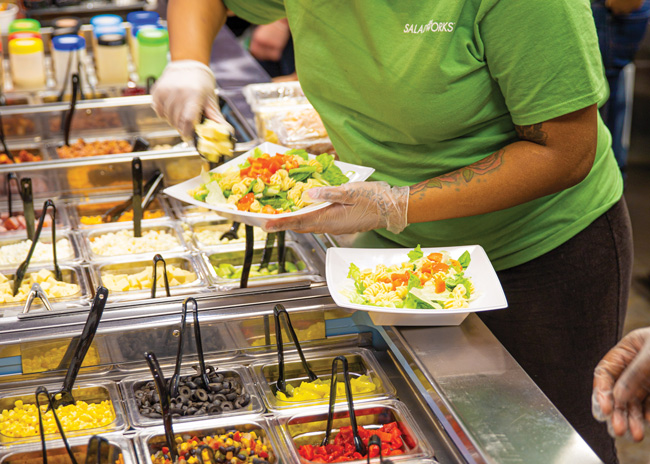
Grocerants and Robots
To grow sales, Saladworks decided to move into a market that made sense for its brand: grocery stores. The first opened in ShopRite in Philadelphia in March 2019 and there are now seven kiosks in supermarkets in Pennsylvania, New York, Maryland and Cincinnati.
The kiosks are around 150 square feet and are located in the produce department “which is always the first thing you see as you walk in,” points out Chief Development Officer Eric Lavinder. Being located here makes the kiosks prominent and gives shoppers plenty of time to think about ordering a salad as they move through the store, he adds.
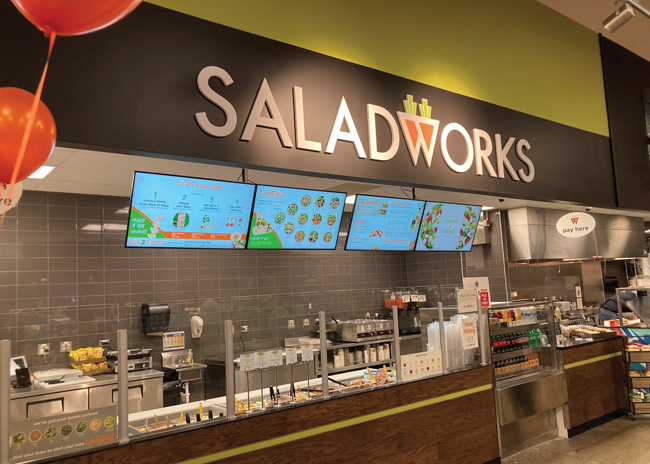 Saladworks has seen success in the grocery segment, adding kiosks inside ShopRite and Kroger (pictured) stores. Image courtesy of SaladworksSaladworks worked with ShopRite to test and figure out how to shrink its in-store plan. “We learned what customer counts we need, what check counts we need; we learned internally what works for our brand,” says Lavinder. And although the program launched a year before COVID arrived, the pandemic actually helped business, Lavinder says, because it closed down traditional self-serve salad bars.
Saladworks has seen success in the grocery segment, adding kiosks inside ShopRite and Kroger (pictured) stores. Image courtesy of SaladworksSaladworks worked with ShopRite to test and figure out how to shrink its in-store plan. “We learned what customer counts we need, what check counts we need; we learned internally what works for our brand,” says Lavinder. And although the program launched a year before COVID arrived, the pandemic actually helped business, Lavinder says, because it closed down traditional self-serve salad bars.
Sales from kiosks are good and Lavinder estimates another 35 will open in grocery stores in 2021. But there are other advantages to them, he says. “They enhance brand awareness and give you exposure to people you wouldn’t normally have had.”
All of Saladworks’ grocery store locations are corporate stores for now. “Until we believe the concept has been fully proven, we don’t want to offer or sell to franchisees,” says Lavinder.
Saladworks is also testing Sally the Robot, a salad vending machine from Chowbotics. So far there’s just one, in the Cancer Treatment Centers of America in Philadelphia. It’s a slow process, Lavinder says, “because people are unsure of new technology.” He sees this as mostly working in healthcare locations because they have “a limited lunch hour and don’t make a lot of money on food. It’s a great alternative to vending machines.”
It also took a lot of time to get the logistics of Sally worked out: Which ingredients would store well and not be smushed by the machine; how would it accept credit cards; how to provide nutritional information.
Saladworks will only deploy a Sally if a store’s not viable, since stores can make much more money. ‘We don’t want to short-sell ourselves,” says Lavinder.
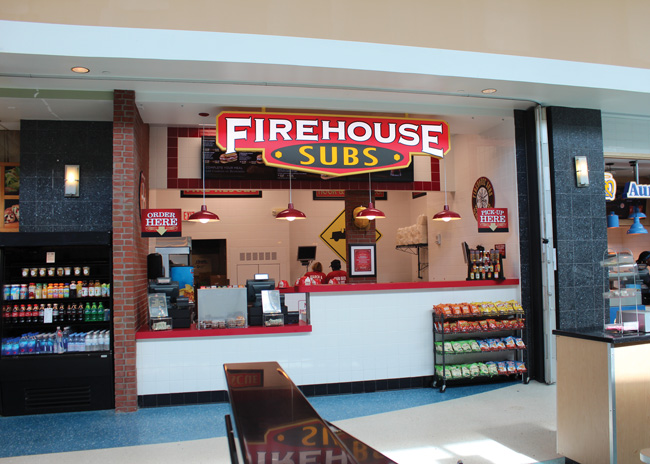 Firehouse Subs opened its first airport location in the chain's hometown of Jacksonville, Fla., in 2017. Image courtesy of Firehouse Subs
Firehouse Subs opened its first airport location in the chain's hometown of Jacksonville, Fla., in 2017. Image courtesy of Firehouse Subs
Captured Audience Spaces
Firehouse Subs is targeting nontraditional locations. To-date the Jacksonville, Fla.-based chain operates in four airports, five college campuses, and at Baptist Methodist Hospital in Jacksonville.
“There’s a growing need for branded restaurants, especially on college campuses,” says Steve LaBostrie, senior manager of nontraditional locations. “Students identify well with brands, and it’s an appealing option outside university cafeterias.”
These locations are smaller (600 to 800 square feet) than Firehouse Subs’ traditional locations (1,400 to 2,500 square feet), giving the growing brand greater flexibility. To fit in that small space, the dining area has been eliminated and the menu abbreviated, which means storage space is also significantly reduced. There are no changes to kitchen equipment.
Only the best-selling menu items are served in nontraditional locations and instead of offering three sub sizes, only one is available. “We need to run these operations lean so they’re more efficient, profitable and offer the best guest experience possible,” LaBostrie points out.
Another advantage to the brand is “the visibility it’s going to give us,” he adds, “It helps open up our brand to new customers. What we’ve found in airports is we’re appealing to existing customers as well as people who’ve never heard of us before. Then when they get home, they look for the closest Firehouse Subs to them.”
The nontraditional locations are all licensed, which means they’re mostly operated by foodservice contractors, LaBostrie points out. Firehouse Subs employees train those staff members and check in with them periodically.
Firehouse Subs will be focusing on opening traditional stores in the future, but with a strong emphasis on nontraditional venues that could go beyond airports, colleges and healthcare and into other locations like travel plazas and casinos.
Since the coronavirus pandemic began, Tampa, Fla.-based Tijuana Flats has opened locations in the football stadiums at both Florida State University and the University of Florida — the concept’s first nontraditional locations. Coming up in the first half of 2021 will be two more sports locations at these universities.
CEO Brian Wright thought long and hard about whether to open the concession stands this year, “but we felt like getting them off the ground and seeing how well they work and what challenges we would encounter while testing with a limited audience,” he says. “We saw this as a kind of practice year.” Plus, with the stands only being open when there are games, the investment is low, he points out.
The Florida State location is a self-operated location; the University of Florida unit is licensed, run by the university’s foodservice contractor, but both look the same from the outside, he says; the differences are on the financial and administrative side.
Tijuana Flats had to make changes to be able to operate in a stadium. Wright cut the menu by 60% to 70%, opting to serve only bestsellers and eliminating anything that took too long to cook. And, the food has to stay warm while patrons return to their seats, so he switched to a different style of packaging.
At the stadiums, there was a limited kitchen, but Wright decided to only do a partial build-out during this first test year and then revamp them next year.
It was important to Wright that each location look like Tijuana Flats’ new prototype that rolled out in late 2020. “It’s very modern, very bright. So, as we move forward, we want to take on the look of our prototype, so the brand is front and center,” he says. “We have a captured audience and these locations are so great for expanding our brand. Thousands of people might be walking by.”
Opening in Florida schools was “logical,” Wright says, since they’re close to the concept’s headquarters and are in the state where it has the most brand recognition. He’s also looking into airports — especially Tampa’s — which he says “will help us get our foot in the market to get into larger and larger spaces.”
Wright will be expanding Tijuana Flats’ presence in nontraditional locations while continuing to grow traditional corporate and franchised stores. “We have such high hopes for nontraditional,” he says. “Having those captured audiences is key.” The traditional stores will support the nontraditional locations, he points out, and serve as an anchor store. Franchisees benefit from the brand exposure.

